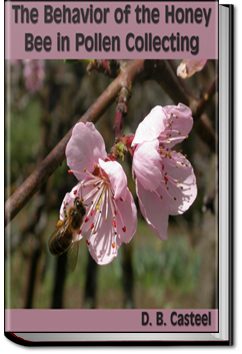

The mouthparts of the bee are also essential to the proper collection of pollen. The mandibles are used to scrape over the anthers of flowers, and considerable pollen adheres to them and is later removed. The same is true of the maxillæ and tongue. From the mouth comes the fluid by which the pollen grains are moistened.
The legs of the worker bee are especially adapted for pollen gathering. Each leg bears a collecting brush, composed of stiff, unbranched hairs set closely together. These brushes are located upon the first or most proximal tarsal segment of the legs, known technically as the palmæ of the forelegs and as the plantæ of the middle and hind pair. The brush of the foreleg is elongated and of slight width (fig. 1), that of the middle leg broad and flat (fig. 2), while the brush upon the planta of the hind leg is the broadest of all, and is also the most highly specialized. In addition to these well-marked brushes, the distal ends of the tibiæ of the fore and middle legs bear many st
Get ALL YOU CAN BOOKS absolutely FREE for 30 days. Download our FREE app and enjoy unlimited downloads of our entire library with no restrictions.
Have immediate access and unlimited downloads to over 200,000 books, courses, podcasts, and more with no restrictions.
Everything you download during your trial is yours to keep and enjoy for free, even if you cancel during the trial. Cancel Anytime. No risk. No obligations.
For just $24.99 per month, you can continue to have unlimited access to our entire library. To put that into perspective, most other services charge the same amount for just one book!

As avid readers, we understand the joy of immersing ourselves in a captivating story or getting lost in the pages of a good book. That's why we founded All You Can Books back in 2010, to create a platform where people can access an extensive library of quality content and discover new favorites.
Since our founding days, we’ve continuously added to our vast library and currently have over 200,000 titles, including ebooks, audiobooks, language learning courses, podcasts, bestseller summaries, travel books, and more! Our goal at All You Can Books is to ensure we have something for everyone.
Join our community of book lovers and explore the world of literature and beyond!